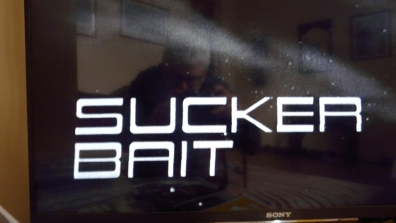“Sucker Bait” was broadcast on 15th November 1965.
Cast: Mark Annuncio_ Clive Endersby, Doctor Sheffield – John Meillon, Fawkes – Roger Croucher, Novee – Burt Kwouk. Captain Follenbee- Bill Nagy
Script: Meade Roberts
Director: Naomi Capon.
Producer and Story Edtor: Irene Shubik, Associate Producer: George Spenton-Foster.
 “Sucker Bait” was a novella first serialised in the February and March 1954 issues of Astounding Science Fiction, and reprinted in the 1955 collection The Martian Way and Other Stories.
“Sucker Bait” was a novella first serialised in the February and March 1954 issues of Astounding Science Fiction, and reprinted in the 1955 collection The Martian Way and Other Stories.
The story begins on the bridge of a spaceship in flight with countless stars visible. (All stories like this seem to begin on the bridge). We are in some undated future where there is a Confederation of 83,000 worlds. Men still wear polo-necks, though, but at least they have the escaped the uniform blond hair of previous episodes. The crew is multi-racial, but there are no women on board.
Captain Follenbee summons a crew member, Mark Annuncio, to see him. Whilst the rest of the crew are scientists, laughing and joking as they go about their various tasks, Annuncio in these opening scenes is established as an outsider, who is regarded with suspicion by the other men. Novee comments, You’ve got to remember he’s a mnemonic, a weird and special lot.

Mark Annuncio (Clive Endersby)
Annuncio gets into an argument with the Captain when he refuses to let him see the ship’s log. He is rescued by Doctor Sheffield who explains who he is, ostensibly for the Captain’s benefit , but really for our benefit what a mnemonic does (mnemonic derives from the Greek word meaning memory).
…Computers are limited, they have to be asked questions. Sometimes it never occurs to people to ask them the right questions. Therefore mankind needs a computer that is non-mechanical, that has some imagination. There is such a computer… in each and every one of us…Somewhere inside the human brain is a record of every fact that’s ever been impinged upon. Very little is consciously remembered,, but it’s all there. A slight association can bring it back to us without knowing where it came from or why. Now that is called “a hunch” or “a feeling”… Now some people are better at it than other. Others are almost perfect, like Mark Annuncio.
So we train them to read, look, listen and do it better and more efficiently. It doesn’t really matter what data they collect. Any data may be useful, and every in no machine could possibly make.once in a while a mnemonic makes a correlation…You see Mark is different from us… mnemonics are taken into the service about the the age of five. In a sens etheya re force-grown. We allow them no contact with normal people in case they develop normal mental habits. They are highly strung, easily upset, and easily ruined. I am here to see that does not happen. mark is an instrumnet, the most valuable instrument on this ship. There are only a hundred like him in the universe.
When he is annoyed (which happens quite often) Annuncio refers to the other crew members as “Non Compos” which Doctor Sheffield explains means “Non Compos Mentis” ie “not of sound mind.”
The ship is heading for a planet called Troas which Mark has identifiied as a planet where a colony was established, but then the colonists all died. Their mission is to find out why. When the ship arives an expedition – which includes Mark and Doctor Sheffield _ is sent to the rocky surface. They find no sign of the colonists, just burial mounds. Increasingly the crew feel uneasy. Fawkes wakes from a dream believing that there was someone in the tent: They’re all around us. Intelligent beings out there now. I’m telling you, I saw in the tent and out here. Novee tries to convince him that it was just a nightmare. but Fawkes is convinced that there is intelligent life on the planet.
However it is Annunncio who realises the real truth of why the colonists died and takes drastic action that saves their lives. He pieces together a number of different facts to reveal that they were poisoned by beryllium, an element that humanity has forgotten about, but about which he once read an obscure paper. Data matters, it seems .
My view is that not a great deal of drama in this story, while the issue as to whether it is morally right to create mnemonics is not touched on.
Naomi Capon (1921-1987), who directed the story, was one of only two women directors working at the BBC in 1965. The other was Paddy Russell.
 Written by
Written by 


